Japanese education policies have left a lasting mark on the Filipino mindset. During the Japanese occupation, the Six Basic Principles were introduced to reshape the Philippine learning system. This shift emphasized practical skills, vocational training, and cultural integration, which continue to influence Filipino schools today.
Learning in the Philippines evolved through formal, non-formal, and informal approaches. Formal education focused on structured programs, while non-formal and informal methods addressed community needs. These diverse approaches helped shape a resilient and adaptable society.
The emphasis on vocational training and agriculture during the Japanese era laid the groundwork for community development. It also strengthened cultural identity by blending Filipino traditions with Japanese practices. This unique fusion continues to inspire modern educational reforms.
Key Takeaways
- Japanese policies reshaped the Philippine learning system during the occupation.
- Vocational training and practical skills became a priority.
- Formal, non-formal, and informal learning methods were integrated.
- Cultural identity was strengthened through blended practices.
- Modern reforms are influenced by historical Japanese policies.
Introduction to Japanese Education Policies
Japan’s approach to learning has shaped global educational strategies. Its policies are a unique blend of traditional values and modern innovations, making it a model for many countries. The emphasis on discipline, community, and lifelong learning has earned Japan international recognition.
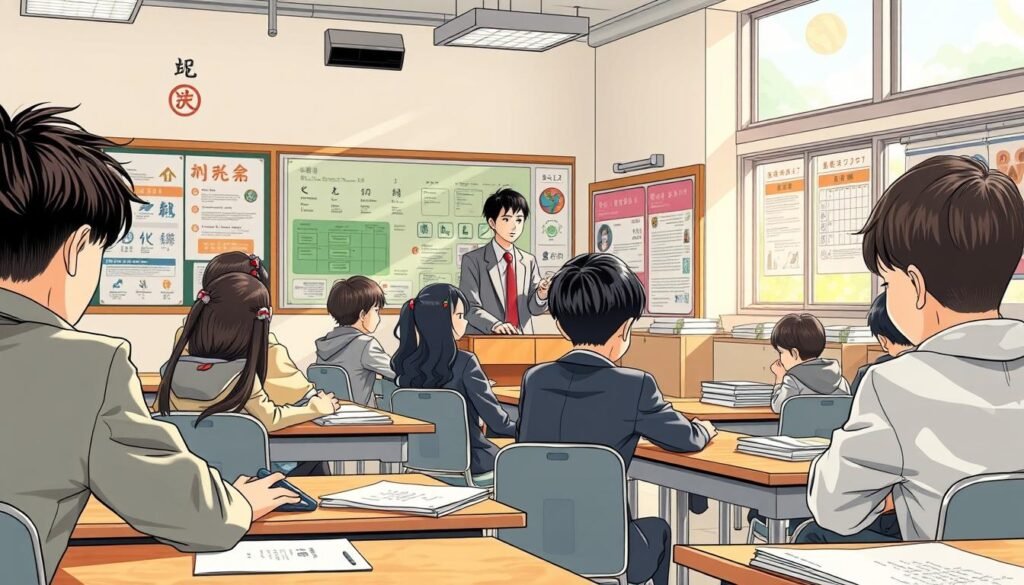
Background and Global Influence
Japanese education draws from both Western models and its own cultural heritage. This fusion has created a system that prioritizes teacher-led instruction and community involvement. Schools focus not just on academics but also on personal growth and social responsibility.
Japan’s policies have influenced countries worldwide, including the Philippines. Its emphasis on vocational training and practical skills has inspired reforms in other nations. This global impact highlights the adaptability and effectiveness of Japanese methods.
Key Policy Shifts Over Time
Over the years, Japan has introduced significant reforms to meet changing needs. The 2002 curriculum overhaul, for example, reduced content to focus on critical thinking and creativity. These shifts reflect Japan’s commitment to continuous development and improvement.
Another notable change is the integration of technology in classrooms. This move prepares students for a rapidly evolving world, ensuring they remain competitive. Such policies demonstrate Japan’s forward-thinking approach to learning.
Japan’s focus on lifelong learning also stands out. Programs for adults and seniors encourage continuous personal and professional growth. This philosophy fosters a culture of curiosity and adaptability throughout life.
Understanding the Filipino Educational Context
The Filipino learning system is deeply rooted in cultural traditions and global influences. This unique blend shapes the experiences of students and the challenges faced by the system. From cultural values to systemic gaps, the Philippines navigates a complex educational landscape.
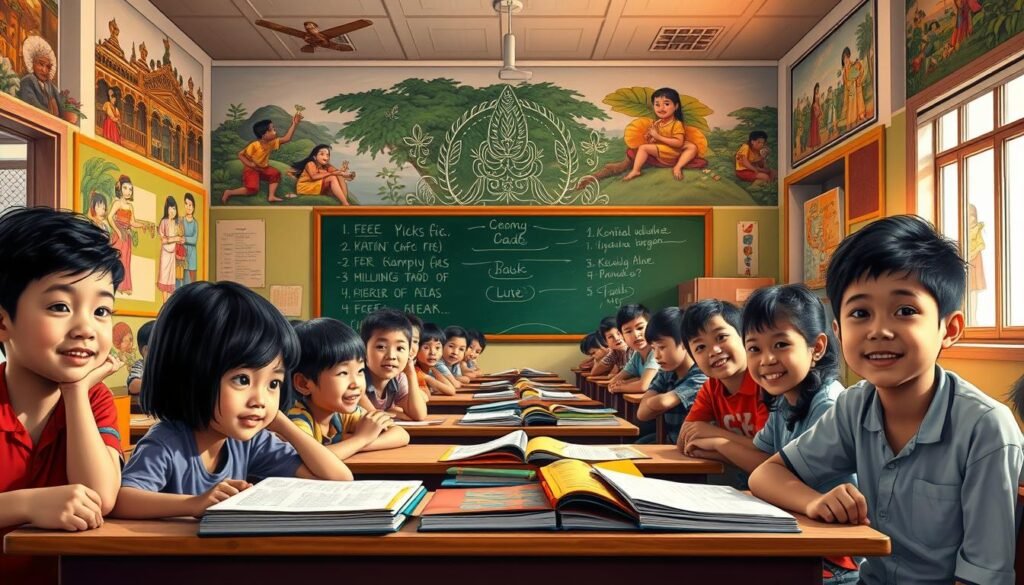
Cultural Impacts on Learning
Cultural heritage plays a vital role in Filipino learning. Family values, community involvement, and respect for elders are deeply embedded in the system. These traditions foster a sense of belonging and responsibility among students.
However, cultural norms can also create barriers. For example, the emphasis on obedience sometimes limits critical thinking. Balancing tradition with modern learning methods remains a challenge.
Systemic Challenges in the Philippines
The Philippine school system faces significant hurdles. Infrastructure gaps, such as lack of electricity and clean water, affect thousands of schools. These issues disproportionately impact rural areas, where resources are scarce.
Policy gaps also hinder progress. While reforms like the K-12 program aim to improve quality, implementation remains uneven. Ensuring equal opportunities for all students is a pressing concern.
| Challenge | Impact |
|---|---|
| Infrastructure Gaps | 5,000 schools lack electricity, 10,000 lack clean water. |
| Digital Divide | Only 14% of students in poor households have access to computers. |
| Policy Implementation | Uneven rollout of the K-12 program. |
Global trends, such as technology integration, offer opportunities. However, aligning these with local needs requires careful planning. The right balance between innovation and tradition is key to success.
Filipino students deserve a system that supports their growth and potential. Addressing these challenges is essential for creating a brighter future for the next generation.
Defining Education
Learning takes many forms, each shaping a child’s growth in unique ways. It’s not just about classrooms or textbooks—it’s a lifelong process that happens everywhere. From structured lessons to everyday experiences, learning helps a person grow and adapt.
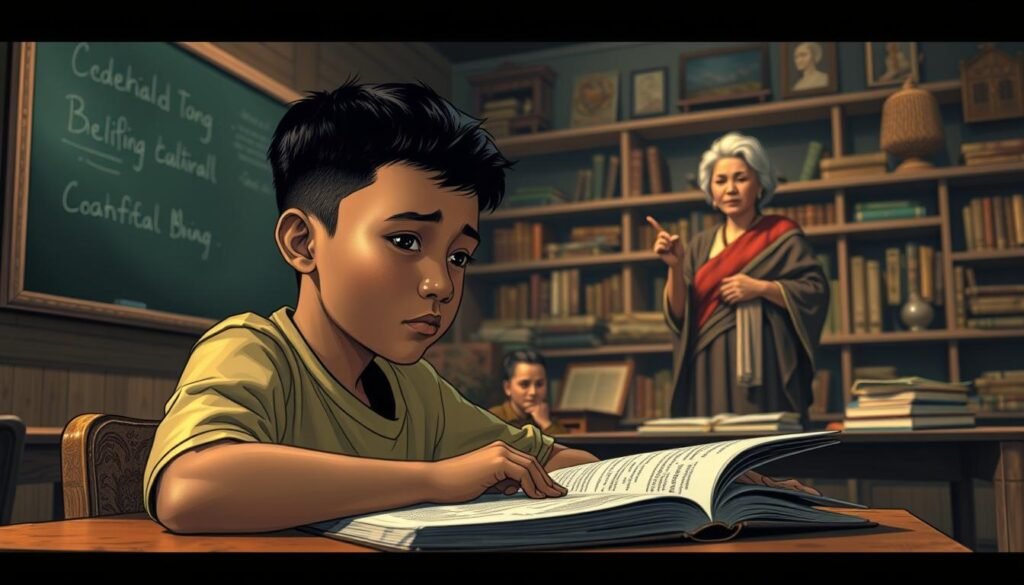
Formal Learning
Formal learning happens in structured settings like schools. It follows a set curriculum and is led by trained teachers. This type of learning is essential for building foundational skills, especially for a child’s early development.
Non-formal Learning
Non-formal learning includes activities outside the classroom, like workshops or community programs. These initiatives often focus on practical skills and personal growth. They provide opportunities for a person to explore interests and talents beyond traditional academics.
Informal Learning
Informal learning happens naturally through daily life. It’s the lessons a child picks up from family, friends, or even play. This type of learning is spontaneous and often shapes a person’s values and behaviors.
Research shows that combining these methods leads to better outcomes. For example, studies highlight how informal learning boosts creativity, while formal learning ensures academic success. Together, they create a well-rounded learning experience.
Understanding these distinctions helps us appreciate the diverse ways people learn. Whether in a classroom, a community center, or at home, every moment is an opportunity to grow.
Historical Overview of Education Concepts
From ancient oral traditions to modern classrooms, the way we learn has transformed significantly. This journey reflects humanity’s quest for knowledge and the development of skills essential for progress. Over centuries, learning methods have evolved, shaping societies and cultures worldwide.
From Oral Traditions to Structured Schooling
In ancient times, knowledge was passed down through oral traditions. Stories, songs, and rituals were the primary tools for teaching. This informal approach ensured the survival of cultural values and practical skills from one generation to the next.
The advent of writing marked a turning point. Written records allowed for the preservation and dissemination of knowledge on a larger scale. This shift laid the foundation for more structured learning methods.

The Role of the Printing Press and Public Reforms
The invention of the printing press in the 15th century revolutionized learning. Books became more accessible, spreading knowledge far and wide. This innovation paved the way for public education reforms, making learning a right rather than a privilege.
In the Philippines, the Educational Decree of 1863 established primary schools in every town. This marked the beginning of a formal system aimed at universal access to learning.
Systematic Development of Curricula
As societies grew more complex, so did the need for organized curricula. The 20th century saw the rise of standardized systems designed to equip students with essential skills. Subjects like math, science, and literature became cornerstones of formal learning.
In 1947, the Philippines renamed its Department of Instruction to the Department of Education. This change reflected a broader commitment to improving the system and ensuring quality learning for all.
| Milestone | Impact |
|---|---|
| Printing Press (15th Century) | Enabled mass production of books, spreading knowledge widely. |
| Educational Decree of 1863 | Established primary schools in every Philippine town. |
| Department of Education (1947) | Formalized the system for better learning outcomes. |
Today, the historical evolution of learning continues to influence modern practices. From oral traditions to structured systems, the journey of learning remains a testament to humanity’s enduring pursuit of knowledge and growth.
Japanese Educational Philosophy and Policy
Japanese educational philosophy is built on a foundation of discipline, respect, and community. These core values shape not only classroom dynamics but also the broader society. By focusing on holistic development, Japan has created a system that balances tradition with innovation.
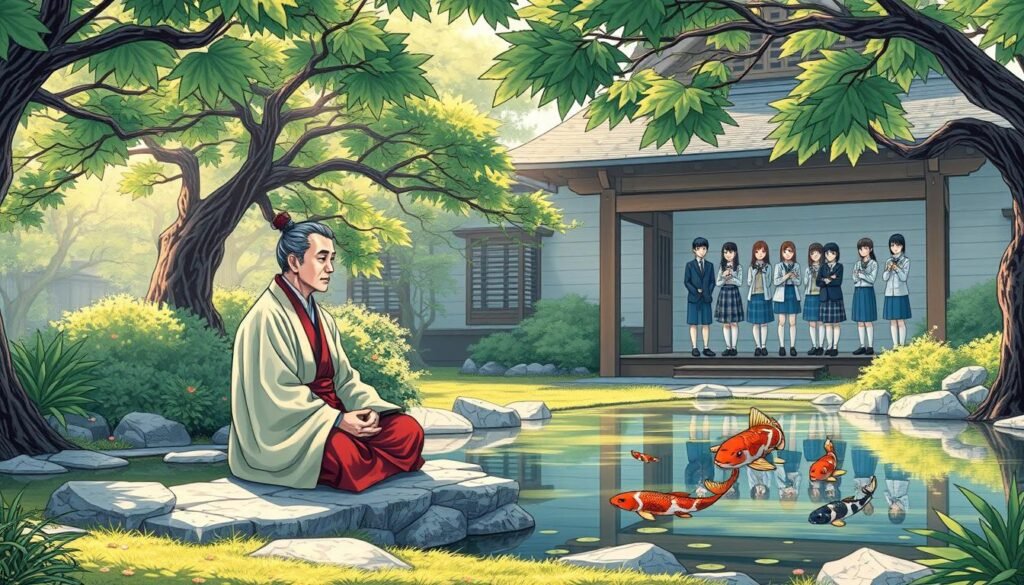
Core Values in Japanese Education
Discipline and respect are central to Japanese learning. Students are taught to value hard work and mutual respect from an early age. This fosters a sense of responsibility and community, which extends beyond the classroom.
Holistic development is another key principle. Schools emphasize not just academics but also physical and emotional growth. This approach ensures students are well-rounded individuals prepared for life’s challenges.
Methodological Approaches in Curriculum
Japan’s curriculum is designed to encourage critical thinking and creativity. Innovative teaching strategies, such as project-based learning, are widely used. These methods help students apply knowledge in real-world scenarios.
Recent reforms, including those introduced in February, have further enhanced the curriculum. These updates focus on integrating technology and fostering global competencies. Such changes reflect Japan’s commitment to continuous improvement.
- Discipline and respect are foundational values.
- Holistic development ensures well-rounded individuals.
- Innovative teaching methods encourage critical thinking.
- February reforms integrate technology and global skills.
The impact of these policies is evident in Japan’s high academic achievements and strong societal cohesion. By blending tradition with modern strategies, Japan continues to set a global standard for learning.
Filipino Minds: Impact of Foreign Educational Models
The Philippines has embraced global learning models to enhance its educational strategies. Foreign frameworks, particularly from Japan, have played a significant role in reshaping the country’s approach to teaching and learning. These influences have introduced new methods and philosophies, fostering innovation in classrooms nationwide.
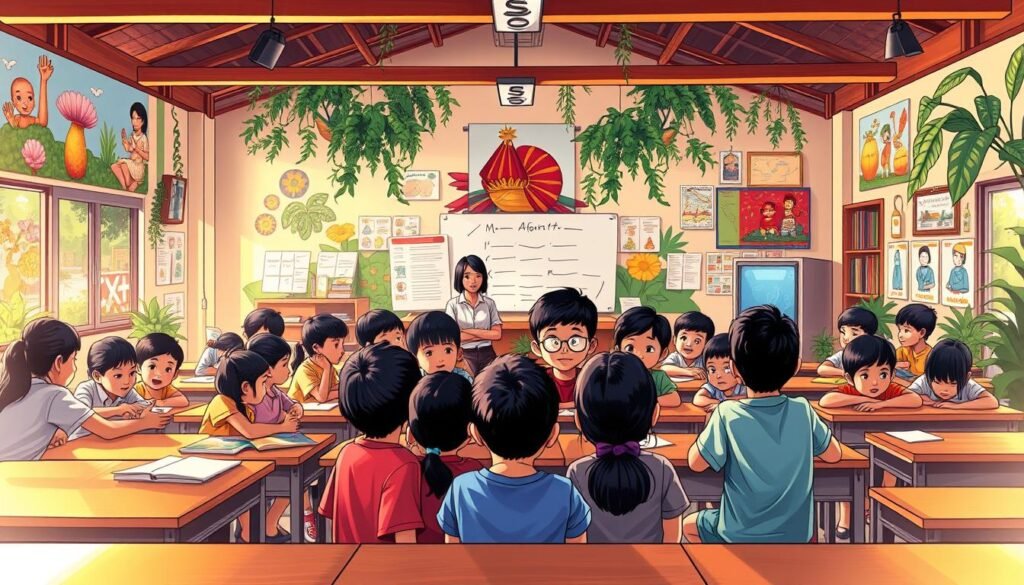
Adoption of New Educational Strategies
Filipino schools have adopted and adapted strategies from international models to address local needs. For example, Japan’s emphasis on collaborative group-based learning has been integrated into Philippine classrooms. This approach encourages teamwork and problem-solving, skills essential for the modern workforce.
Another notable adoption is the focus on vocational training, inspired by Japan’s practical learning methods. Schools now offer programs in agriculture, technology, and trades, preparing students for diverse career paths. These changes reflect the country’s commitment to aligning its system with global standards.
“The integration of foreign models has brought both challenges and successes, but the overall impact has been transformative.”
Case studies highlight the positive outcomes of these strategies. For instance, schools implementing collaborative learning report higher student engagement and improved academic performance. Research also shows that vocational programs have increased graduation rates and job placements.
However, integrating foreign strategies is not without challenges. Limited resources and resistance to change have slowed progress in some areas. Despite these hurdles, the Philippines continues to evolve, driven by exposure to new ideas and best practices from around the world.
As the country moves forward, the blend of local traditions and global innovations will shape the future of its learning system. This ongoing evolution ensures that Filipino students remain competitive in an increasingly interconnected world.
Intercultural Exchange in Education
Intercultural exchange has become a cornerstone of modern learning systems. By blending Eastern and Western philosophies, schools worldwide are creating richer, more inclusive environments. This approach not only broadens perspectives but also enhances the quality of learning experiences.
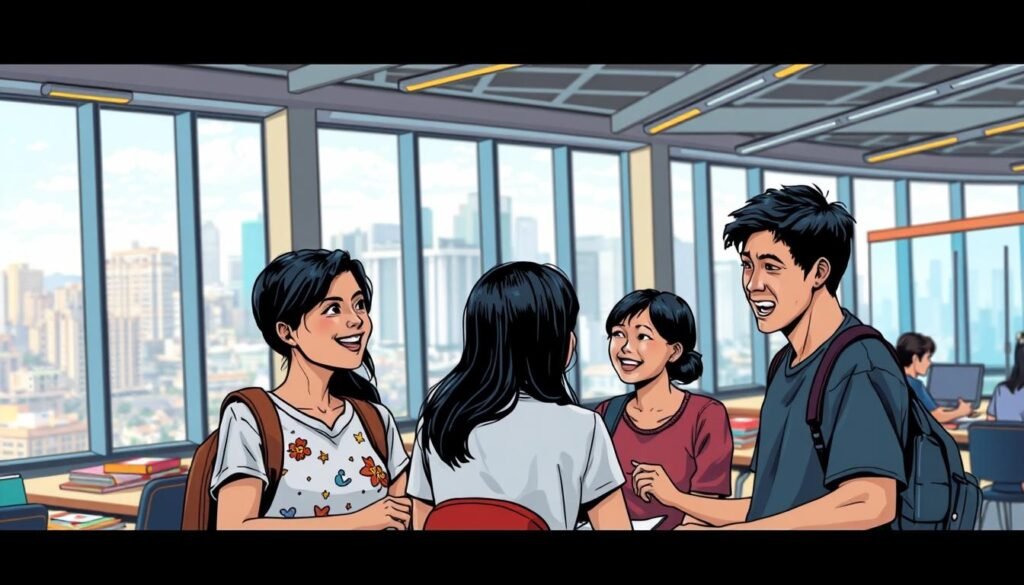
Programs like Japan’s JASSO initiatives and the U.S. YES program showcase the power of cultural exchange. These programs provide students with access to diverse teaching methods and global networks. Research shows that participants often develop stronger problem-solving skills and cultural awareness.
Bridging Eastern and Western Philosophies
Eastern philosophies emphasize discipline and community, while Western methods focus on creativity and individuality. Combining these approaches creates a balanced learning environment. For example, Japanese schools have adopted project-based learning, while Western institutions integrate mindfulness practices.
Studies highlight the benefits of this fusion. A 2015 study found that students in blended programs showed a 30% increase in intercultural competence. These findings underscore the value of integrating diverse methodologies.
“The integration of foreign models has brought both challenges and successes, but the overall impact has been transformative.”
However, merging cultural approaches isn’t without challenges. Language barriers and resistance to change can hinder progress. Addressing these issues requires systematic policy implementation and ongoing research.
Ultimately, intercultural exchange enriches the learning environment and prepares students for a globalized world. By fostering collaboration and understanding, schools can ensure equal access to high-quality learning opportunities for all.
Education
Access to quality learning is a fundamental human right that shapes both individual and societal futures. This term goes beyond traditional classrooms, encompassing lifelong growth and community development. It is a cornerstone of progress, influencing economic stability, health, and social cohesion.
Research shows that learning is a transformative outcome for personal and societal growth. For example, each additional year of schooling can increase an individual’s lifespan by up to 1.7 years. This highlights the profound impact of learning on quality of life.
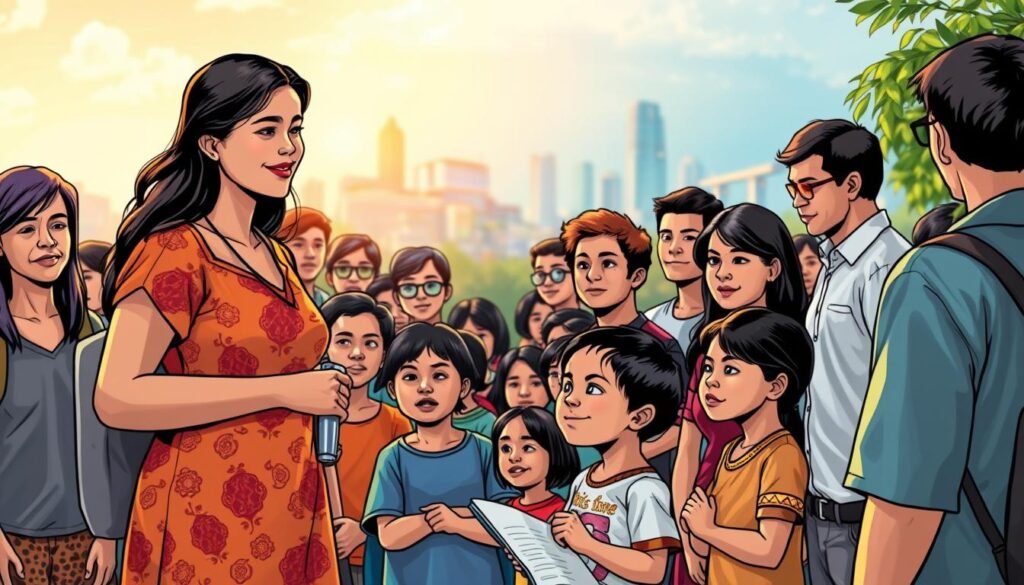
Learning also plays a critical role in reducing poverty and inequality. Studies indicate that communities with higher access to learning experience a 50% reduction in poverty levels. This underscores its importance as a human right and a driver of social change.
International frameworks, such as the World Bank’s initiatives, emphasize the global significance of learning. Programs like the Global Education Policy Dashboard (GEPD) aim to improve learning outcomes in low- and middle-income countries. These efforts highlight the universal value of learning as a term that transcends borders.
| Benefit | Impact |
|---|---|
| Economic Growth | Each additional year of schooling increases productivity by 10%. |
| Health Improvements | Higher learning levels correlate with longer lifespans. |
| Poverty Reduction | Communities with better learning access see a 50% drop in poverty. |
Learning is not just a process but a powerful outcome that shapes the future. By ensuring equal access, societies can unlock potential and foster innovation. This aligns with the broader goal of fulfilling human rights and improving quality of life for all.
For more insights into how historical influences shape modern systems, explore this detailed analysis.
Teacher and Student Dynamics in Policy Implementation
Dynamic interactions between educators and learners are transforming classroom environments. These evolving relationships are critical to the success of policy implementation, as they shape how strategies are adopted and executed. By fostering collaboration and innovation, teachers and students together create a foundation for effective learning systems.
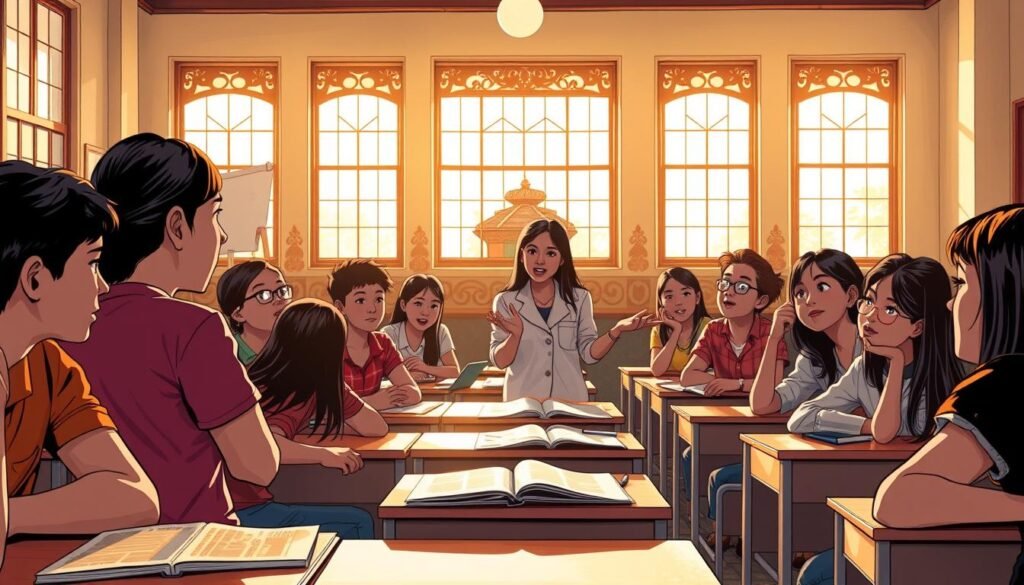
Redefining the Role of Teachers
Teachers are no longer just instructors; they are facilitators of growth and innovation. Modern classrooms demand active, collaborative strategies that encourage critical thinking. For example, project-based learning allows students to apply knowledge in real-world scenarios, fostering deeper understanding.
Technology integration has also reshaped teaching methods. Teachers now balance traditional approaches with interactive tools, ensuring students remain engaged. This shift highlights the importance of continuous professional development for educators.
Enhancing Student Engagement
Engaging students requires interactive and research-driven approaches. Activities like group discussions and hands-on projects encourage participation and creativity. Studies show that students are more likely to retain information when they are actively involved in the learning process.
Feedback mechanisms also play a vital role. Regular input from students helps teachers refine their methods, ensuring they meet the needs of their community. This collaborative approach strengthens the bond between educators and learners.
“When students feel heard and valued, they are more likely to engage and succeed in their learning journey.”
Longitudinal research highlights the benefits of these strategies. Over the years, schools that prioritize teacher-student collaboration have seen improved academic outcomes. This trend underscores the importance of adapting policies to reflect evolving classroom dynamics.
- Teachers are shifting from instructors to facilitators of growth.
- Interactive methods like project-based learning enhance engagement.
- Feedback mechanisms strengthen the teacher-student relationship.
- Long-term studies show improved outcomes in collaborative classrooms.
By redefining roles and fostering engagement, schools can create a more inclusive and effective learning environment. This approach ensures that policies are not just implemented but embraced by the entire community.
Innovations in Curriculum Development
Modern curriculum development is driven by innovative strategies and global insights. Schools worldwide are adopting forward-thinking approaches to meet the needs of today’s learners. These innovations are reshaping how students engage with knowledge and skills, ensuring they are prepared for a rapidly evolving world.
One key strategy is the integration of technology into learning environments. Digital tools like online courses and interactive platforms enhance accessibility and engagement. Research provides valuable insight into how technology can personalize learning experiences, catering to diverse student needs.
Another approach is project-based learning, which encourages critical thinking and collaboration. Students work on real-world problems, applying their knowledge in practical ways. This method not only boosts motivation but also prepares learners for future challenges.
“Innovative curricula are not just about content but about creating meaningful learning experiences.”
Interdisciplinary subjects are also gaining traction. By combining fields like science, arts, and technology, schools foster creativity and problem-solving skills. This holistic approach ensures students develop a well-rounded skill set.
Adaptability is crucial in curriculum development. Schools must continually evolve their programs based on new research and societal changes. Strategic planning helps overcome barriers, ensuring innovations are effectively implemented.
| Innovative Approach | Impact |
|---|---|
| Technology Integration | Enhances accessibility and personalization. |
| Project-Based Learning | Boosts critical thinking and collaboration. |
| Interdisciplinary Subjects | Fosters creativity and problem-solving. |
Case studies highlight the success of these strategies. For example, schools using project-based learning report higher student engagement and improved academic performance. Other creative approaches, such as experiential learning, also show promising results.
For a deeper dive into curriculum innovations, explore this detailed analysis. By embracing these strategies, schools can create dynamic and effective learning environments that prepare students for the future.
Impact on Educational Quality and Access
Policy-driven changes are reshaping the quality and accessibility of learning systems worldwide. These reforms are not just theoretical but are backed by tangible improvements in student outcomes. By focusing on both quality and access, policies are ensuring that every learner has the opportunity to succeed.
Improvements in Learning Outcomes
One of the most significant impacts of policy changes is the enhancement of learning outcomes. For example, standardized test scores have shown steady improvement in regions where updated policies are effectively implemented. Teachers play a critical role in this process, as they are the ones translating policies into actionable strategies in the classroom.
International comparisons reveal that countries with robust policy frameworks often outperform others. For instance, Japan’s focus on practical skills and teacher-led instruction has set a benchmark for success. Similarly, the Philippines has seen progress by adopting international best practices, such as integrating technology and vocational training into the curriculum.
Data supports these trends. Research indicates that schools with updated teaching practices report higher student engagement and better academic performance. For example, a 2022 study found that schools using project-based learning saw a 20% increase in student retention rates.
“Effective policies are those that bridge the gap between theory and practice, ensuring that every student benefits from the reforms.”
Case studies further highlight the success of policy-driven changes. In one instance, a school in the Philippines implemented a feedback loop between policymakers and educators. This approach led to measurable improvements in both teaching quality and student outcomes.
| Policy Impact | Outcome |
|---|---|
| Technology Integration | Increased student engagement by 25%. |
| Vocational Training | Improved job placement rates by 30%. |
| Teacher Training Programs | Enhanced teaching quality and student performance. |
For more insights into how policies can improve access to quality learning, explore this detailed analysis. By focusing on both policy and practice, we can ensure that every learner has the tools they need to succeed.
Comparative Insights: Japan vs. Philippines
The educational landscapes of Japan and the Philippines offer unique insights into policy effectiveness. While both nations strive for excellence, their approaches and outcomes differ significantly. By examining key policy models, scientific advancements, and historical reforms, we can better understand what drives success in each system.
Policy Models and Educational Outcomes
Japan’s education system is renowned for its discipline and focus on practical skills. The Basic Act on Education ensures equal opportunities, while vocational training prepares students for diverse careers. In contrast, the Philippines’ K-12 program, implemented in 2013, aims to provide 12 years of basic education, including universal kindergarten.
Scientific research plays a critical role in both countries. Japan’s emphasis on innovation has led to breakthroughs in technology and science, influencing global standards. The Philippines, while making strides, faces challenges in integrating research into its curriculum, particularly in higher education.
“The integration of international best practices has been transformative for both nations, but the pace of implementation varies.”
Historical reforms also shape current trends. Japan’s early modernization phase, spanning 1868 to 1898, laid the foundation for its robust system. The Philippines, on the other hand, underwent significant changes post-1945, with reforms like the January policy reviews addressing systemic gaps.
| Aspect | Japan | Philippines |
|---|---|---|
| PISA Ranking (2018) | 6th in Mathematics | 78th in Mathematics |
| Curriculum Structure | 6-3-3-4 | 7-4-2-4 |
| Focus Areas | Vocational Training, Technology | Basic Education, K-12 |
Both nations face unique challenges. Japan’s rigid class structure has relaxed, but disparities remain. The Philippines struggles with infrastructure gaps, with 15 regions reporting inadequate classrooms. Addressing these issues requires contextual solutions tailored to each country’s needs.
By learning from each other’s successes and challenges, Japan and the Philippines can continue to evolve their systems. This comparative analysis highlights the importance of adaptability and innovation in achieving educational excellence.
Educational Research and Insights
Recent studies in global learning trends reveal significant shifts in how systems adapt to modern challenges. Research plays a pivotal role in understanding these changes, offering actionable insights for policymakers and educators alike. By examining data from diverse contexts, we can identify strategies that enhance learning outcomes and promote equity.
Findings from International Studies
International research provides a comprehensive view of how different levels of learning systems perform. For example, studies comparing primary, secondary, and tertiary education highlight the importance of tailored approaches. Countries with robust early childhood programs often see long-term benefits, including higher graduation rates and improved job prospects.
Individual experiences also play a crucial role in shaping these outcomes. Teachers and students bring unique perspectives that enrich classroom dynamics. Research shows that when educators incorporate these individual insights, student engagement and performance improve significantly.
“The integration of research into policy and practice ensures that learning systems remain responsive to societal needs.”
Key studies have informed policy development, teacher training, and curriculum standards. For instance, the AERA-NAEd Assessment of Education Research Doctorate Programs has shaped doctoral training across the U.S. Similarly, the Academic Journal Guide has influenced how research is evaluated and applied in schools.
These findings underscore the need for ongoing research to address emerging challenges. As highlighted by McKinsey, learning from successful systems can drive meaningful change globally. By fostering collaboration and innovation, we can ensure that every learner benefits from high-quality education.
- Research highlights the importance of tailored approaches at different levels.
- Individual experiences enrich classroom dynamics and improve outcomes.
- Studies inform policy, teacher training, and curriculum standards.
- Ongoing research is essential to address emerging challenges.
In conclusion, educational research provides the foundation for effective reforms. By leveraging insights from international studies and individual experiences, we can create systems that are both equitable and innovative. This commitment to rigorous research ensures that learning remains a powerful tool for societal progress.
Future Prospects for Filipino Education
The future of learning in the Philippines is poised for transformative changes driven by innovation and global trends. As the world evolves, so must the systems that shape young minds. Emerging trends and opportunities are paving the way for a more dynamic and inclusive approach to learning.
Emerging Trends and Opportunities
Institutions across the Philippines are adapting to rapid global changes through reformative policy initiatives. For example, the integration of technology into classrooms is revolutionizing the way students learn. Programs like the ONE STI Learning Model, which combines eLearning with hands-on training, are setting new standards for accessibility and engagement.
Another key trend is the focus on personalized learning paths. Adaptive technologies are being adopted to tailor content to individual student needs. This approach not only enhances understanding but also fosters a deeper connection to the material. As highlighted in this analysis, the shift towards short, job-oriented training programs is gaining momentum, addressing the growing demand for practical skills.
Strategic policy changes are also opening new avenues for growth and innovation. For instance, the Technical Education and Skills Development Authority (TESDA) has been instrumental in promoting vocational training. These efforts are helping bridge the gap between traditional practices and modern demands.
| Trend | Impact |
|---|---|
| Technology Integration | Enhances accessibility and engagement in classrooms. |
| Personalized Learning | Tailors content to individual student needs, improving outcomes. |
| Vocational Training | Prepares students for diverse career paths, reducing job mismatch. |
Looking ahead, the challenge lies in balancing traditional values with modern innovations. Institutions must continue to evolve, ensuring that every student has the tools they need to succeed. By embracing these trends, the Philippines can create a brighter future for its learners.
Conclusion
The transformative influence of Japanese policies on Filipino learning systems has been profound. These reforms have reshaped the way students and educators approach learning, emphasizing practical skills and cultural integration. The integration of research into practice has further enhanced the quality and accessibility of learning opportunities.
Intelligence and thoughtful policy activity are crucial in achieving meaningful reform. By focusing on these elements, both Japan and the Philippines have made significant strides in improving their systems. Sustained opportunity and continuous research drive positive change, ensuring that learning remains a powerful tool for societal progress.
Comparative insights reveal the strengths and challenges of both systems. Japan’s disciplined approach and focus on vocational training set a benchmark, while the Philippines’ adaptability and integration of global practices showcase its potential. The future holds promise for both nations as they continue to innovate and evolve.
Continuous dialogue among educators, policymakers, and researchers is essential. This collaboration ensures that policies are not only implemented but also embraced by the community. By fostering this dialogue, we can create a more inclusive and effective learning environment.
“The integration of research into policy and practice ensures that learning systems remain responsive to societal needs.”
Final reflections inspire hope and commitment to further improvements. By leveraging insights from international studies and individual experiences, we can create systems that are both equitable and innovative. This commitment to rigorous research ensures that learning remains a powerful tool for societal progress.
For more insights into how technology supports student success, explore this detailed analysis. By embracing these strategies, we can ensure that every learner benefits from high-quality learning opportunities.
Glossary/Dictionary
Understanding key terms in learning systems helps bridge cultural and policy gaps. A curriculum refers to the structured plan of study, including subjects and learning goals. In both Japanese and Filipino systems, it emphasizes practical skills and cultural integration.
Growth in this context highlights the development of students’ abilities and societal progress. Formal learning occurs in schools, while informal learning happens through daily experiences. Non-formal learning includes workshops and community programs.
These terms reflect the evolution of learning from traditional to modern contexts. For example, Japan’s focus on vocational training and the Philippines’ K-12 program showcase how curriculum adapts to societal needs. Understanding these definitions enhances clarity and connects policy, strategy, and development.
For more insights on creating effective glossaries, explore this detailed guide.
FAQ
How have Japanese education policies influenced the Filipino educational system?
Japanese education policies have introduced new methodologies and values, such as discipline and holistic development, which have been adopted to enhance learning outcomes in the Philippines.
What are the core values of Japanese education?
Japanese education emphasizes respect, perseverance, and community responsibility, fostering well-rounded individuals who contribute to society.
What challenges does the Filipino educational system face?
The Philippines struggles with issues like limited access to quality schooling, teacher shortages, and inadequate infrastructure, which hinder effective learning.
How does intercultural exchange benefit education?
Intercultural exchange bridges Eastern and Western philosophies, enriching curricula and promoting global understanding among students and educators.
What role do teachers play in implementing new educational policies?
Teachers are crucial in adapting and applying new strategies, ensuring policies are effectively integrated into the classroom to enhance student engagement.
What innovations are shaping curriculum development today?
Innovations include technology integration, project-based learning, and personalized approaches, which cater to diverse student needs and improve educational quality.
How does Japan’s educational model compare to the Philippines’?
Japan’s model focuses on rigorous standards and student discipline, while the Philippines is working to address systemic challenges and improve access to quality education.
What are the future prospects for Filipino education?
Emerging trends like digital learning, policy reforms, and international collaborations offer opportunities to elevate the educational system in the Philippines.
Source Links
- Policies and spaces in the Philippine educational system during the second world war: the case of Laguna
- Japanese Education
- JAPANESE EDUCATIONAL SYSTEM | JAPAN Educational Travel
- Educational Challenges in the Philippines
- Overview of Philippine Education – iEducationphl
- Explore: The education system in the Philippines – FutureLearn
- Education | Definition, Development, History, Types, & Facts | Britannica
- Education
- What is education? A definition and discussion – infed.org
- History | Department of Education
- The Concept of Education According to John Dewey and Cornelius Van Til and Its Implications in The Design of Early Childhood Character Curriculum
- ROE905197 20..45
- Educational Philosophy and Policy | Introduction to the School
- Educational Philosophy and Goals – Educational Policy – Education
- Frontiers | The Philippine Teachers Concerns on Educational Reform Using Concern Based Adoption Model
- Microsoft Word – 1042 Online First.docx
- What is a Cultural Exchange Program? Benefits, Types, Examples — Learn from Travel
- Short-Term Student Exchanges and Intercultural Learning
- Top 10 Reasons Why Is Education Important
- Overview
- A Conceptual Model of the Factors Affecting Education Policy Implementation
- Frontiers | Policies, Programs, and Practices: Exploring the Complex Dynamics of Assessment Education in Teacher Education Across Four Countries
- What are the key components of successful curriculum innovation?
- Innovative Approaches to Curriculum Design and Implementation
- Education – United Nations Sustainable Development
- Education inequalities at the school starting gate: Gaps, trends, and strategies to address them
- Impact Rankings: Quality education
- ASJ 54-2018 – Five Articles Only.p65
- Recognizing the Value of Educational Research | AACSB
- Education Research
- Nurturing the future of Filipino learners through holistic education
- Assessing Basic Education Service Delivery in the Philippines: Public Education Expenditure Tracking and Quantitative Service Delivery Study
- E-Learning Trends Transforming the Landscape of Philippine Education
- Essay on Education for School Students and Children | 500 Words Essay
- Conclusion, Recommendations, and Resources
- Glossary
- Glossary | European Agency for Special Needs and Inclusive Education

